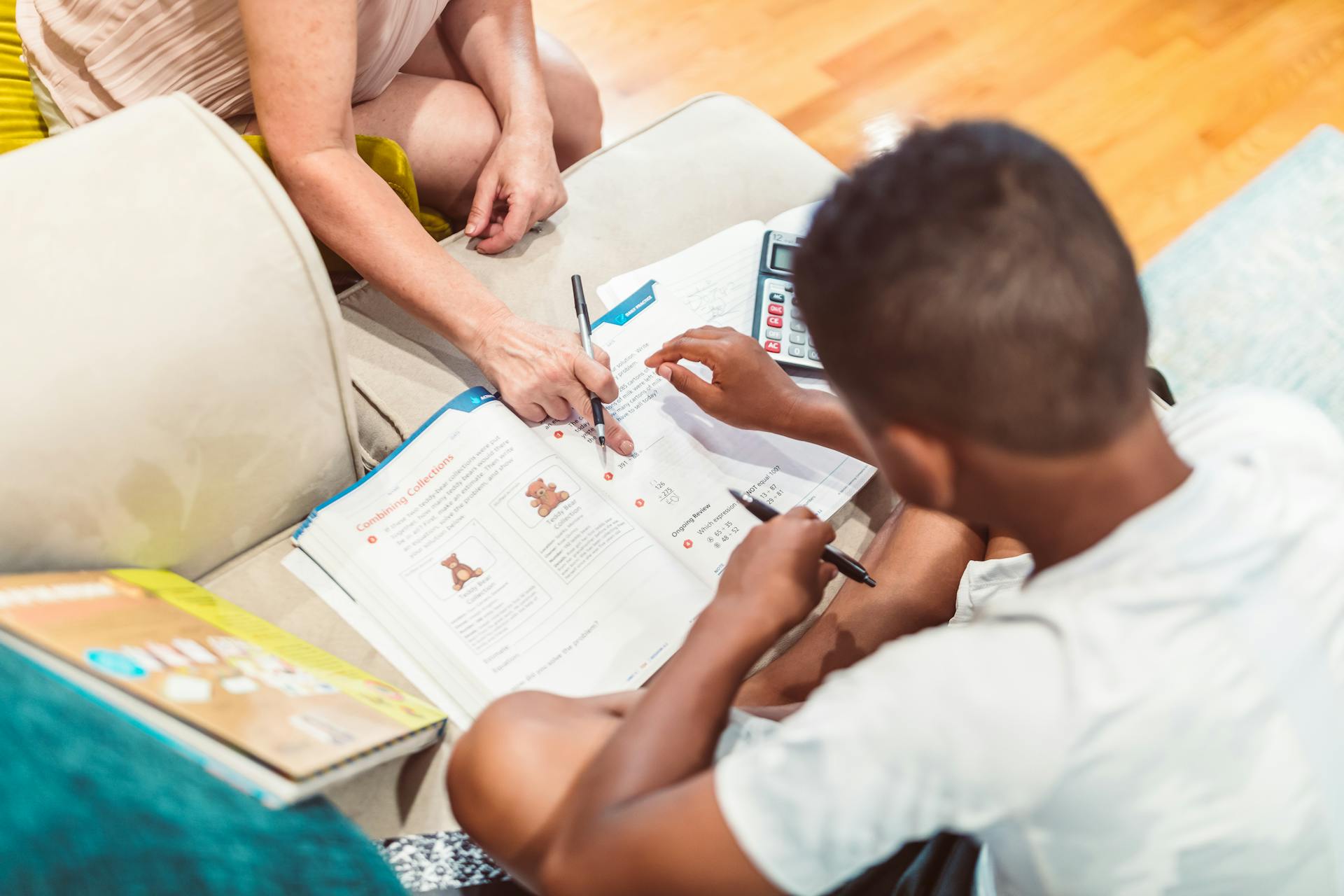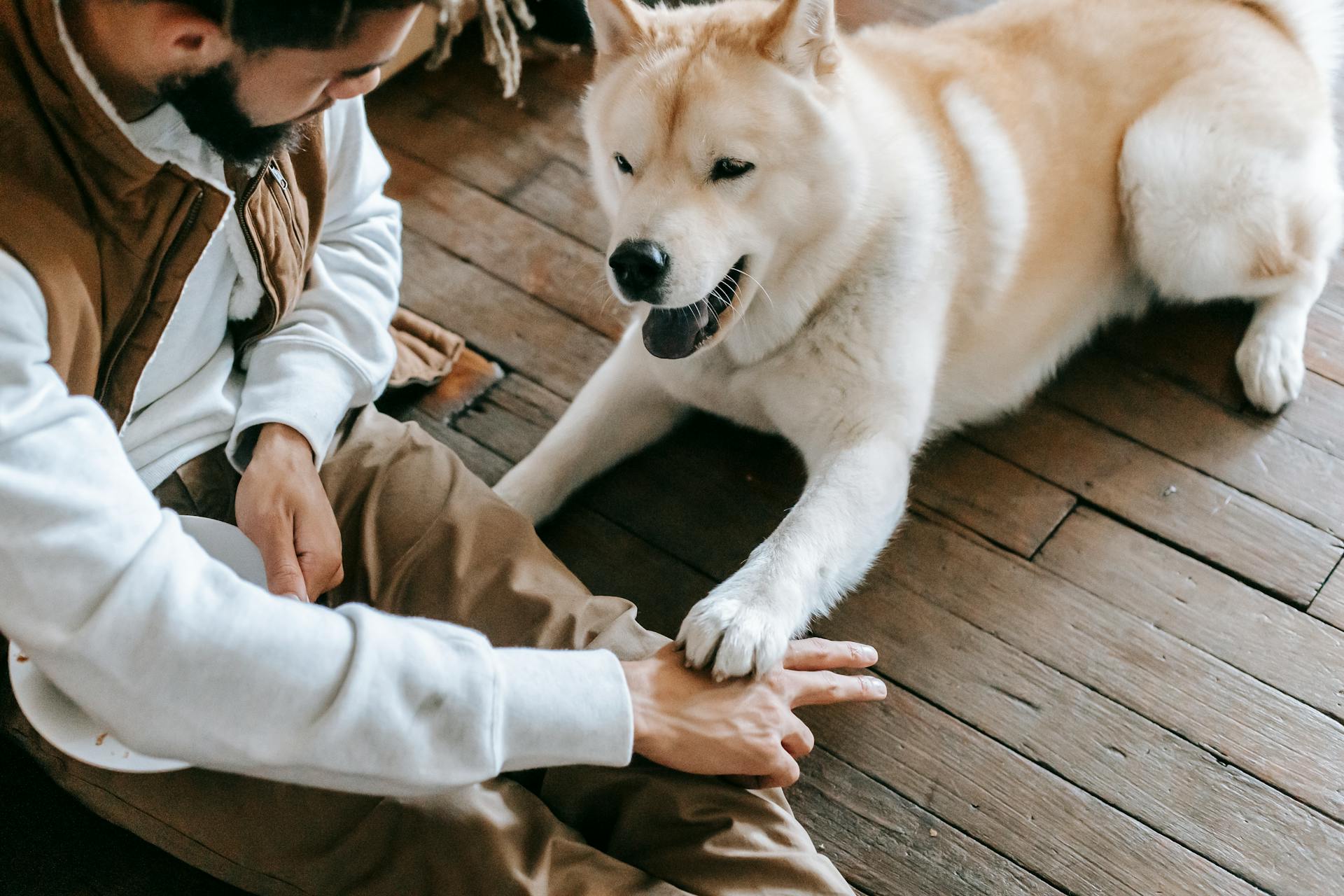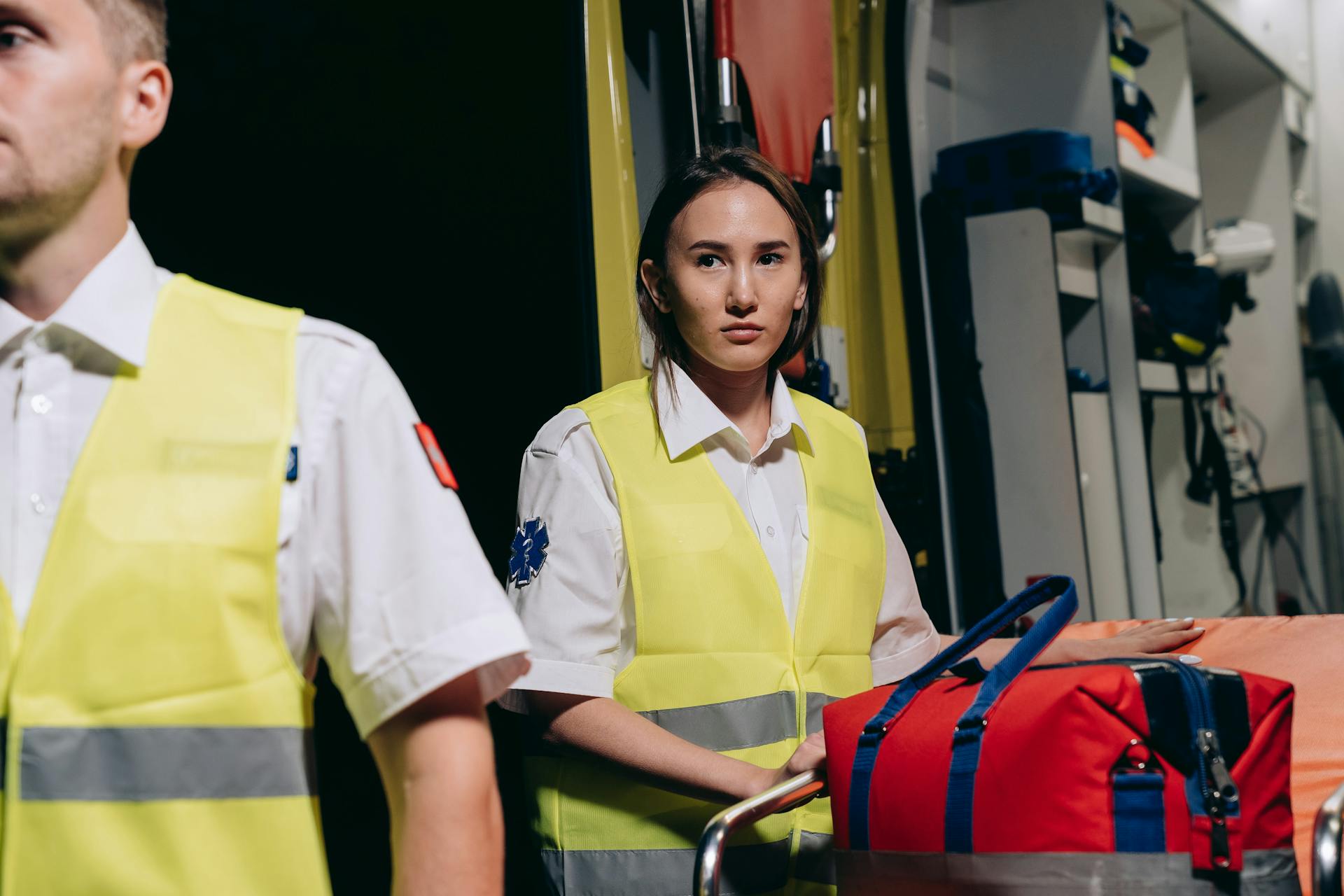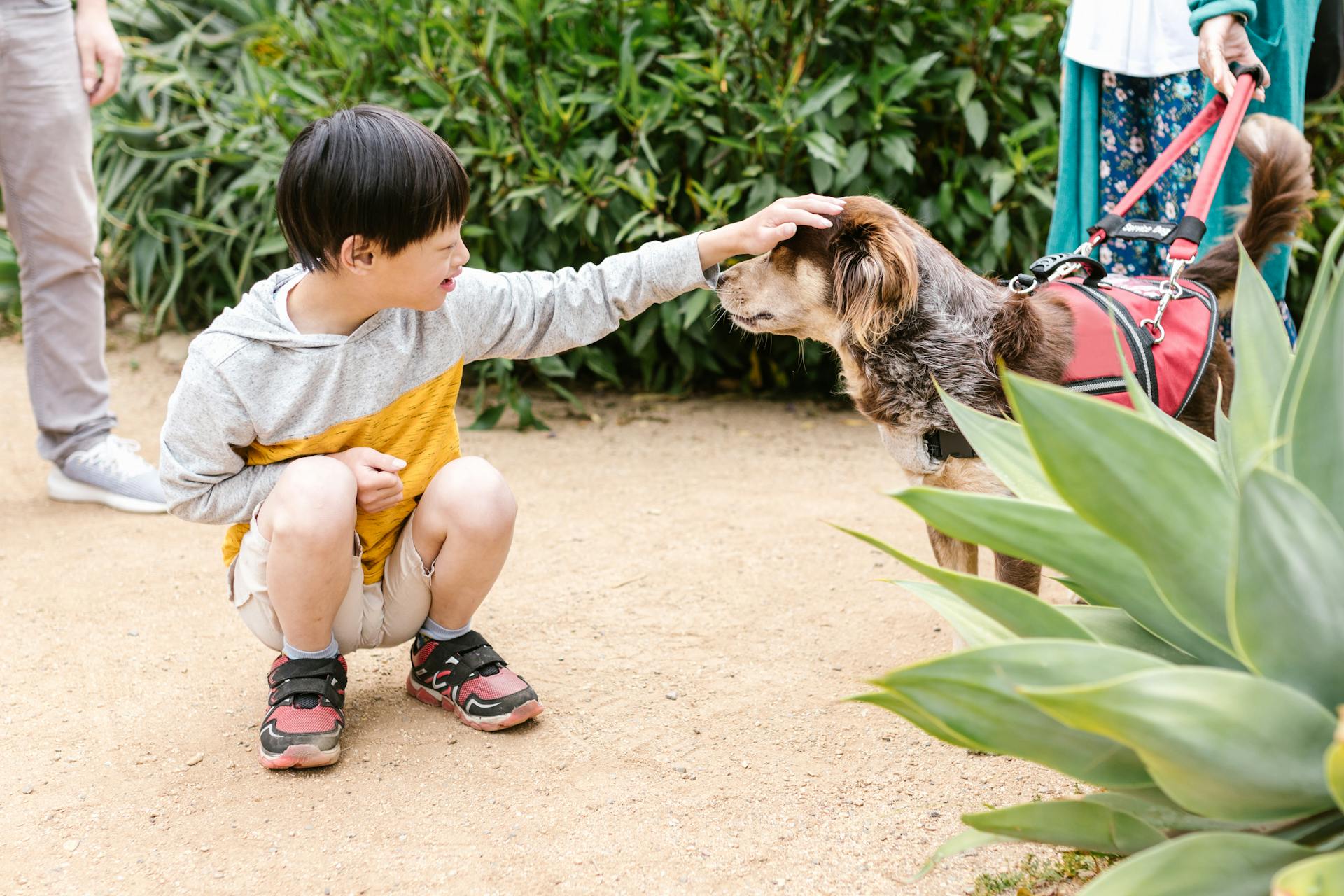
Autism assistance dogs can be trained to perform a wide range of tasks to help individuals with autism.
These tasks can include providing physical support, interrupting self-injurious behaviors, and reminding individuals to take their medication.
Some autism assistance dogs are also trained to help their owners navigate through crowded areas.
Individuals with autism often struggle with sensory overload, and autism assistance dogs can provide a sense of calm and comfort.
By providing emotional support and stability, autism assistance dogs can greatly improve the quality of life for individuals with autism.
Expand your knowledge: Autism Dog Training near Me
What is Autism Assistance?
Autism Assistance is a type of service dog training that helps individuals with Autism Spectrum Disorder (ASD) navigate everyday life.
These dogs are trained to assist individuals with specific needs such as anxiety, sensory processing, and social interactions.
Research has shown that individuals with ASD often have difficulty with social cues and may experience anxiety in crowded areas.
Autism Assistance dogs are trained to provide a sense of calm and comfort in these situations.
Expand your knowledge: Service Dogs for Panic Attacks
By providing emotional support and stability, Autism Assistance dogs can help individuals with ASD feel more confident and independent.
In many cases, Autism Assistance dogs are also trained to interrupt self-injurious behaviors and provide a sense of grounding during meltdowns.
Studies have shown that the presence of an Autism Assistance dog can significantly reduce anxiety and stress levels in individuals with ASD.
With proper training and support, Autism Assistance dogs can make a huge difference in the lives of individuals with ASD and their families.
Curious to learn more? Check out: Financial Assistance for Dog Training
History and Process
The history of autism assistance dogs is a remarkable one, with the first dog being trained by Chris Fowler in 1997.
Autism is a lifelong disability with characteristics that vary from person to person, and training for autism assistance dogs is similar to guide dog training.
These dogs can cost between $12,000 and $30,000, which is a significant investment for many families.
The process of getting an autism assistance dog involves an interview with a Dogs for Better Lives associate, where all household members must be present.
A different take: Psychiatric Assistance Dog
A final decision is made after reviewing the entire application packet, and the waiting period is approximately 36 months from acceptance.
The training process includes an in-home visit with a trainer who teaches the child and family how to keep the dog working consistently and maintain its obedience training.
Regular communication is required after placement, and the client reports on the dog's progress, with the trainer offering help and answering questions as needed.
For your interest: How to Become a Dog Trainer for Service Dogs
History
The first autism assistance dog was trained by Chris Fowler in 1996, who founded the organization National Service Dogs.
Autism is a lifelong disability, and its characteristics can vary greatly from person to person.
The training for autism assistance dogs is similar to guide dog training, requiring specialized care and attention.
Autism assistance dogs can cost anywhere between $12,000 and $30,000, which can be a significant financial burden for many families.
There is often a long wait list for autism assistance dogs, which can be frustrating for those in need of their support.
For your interest: Autism Assistance Dog Training
Our Process
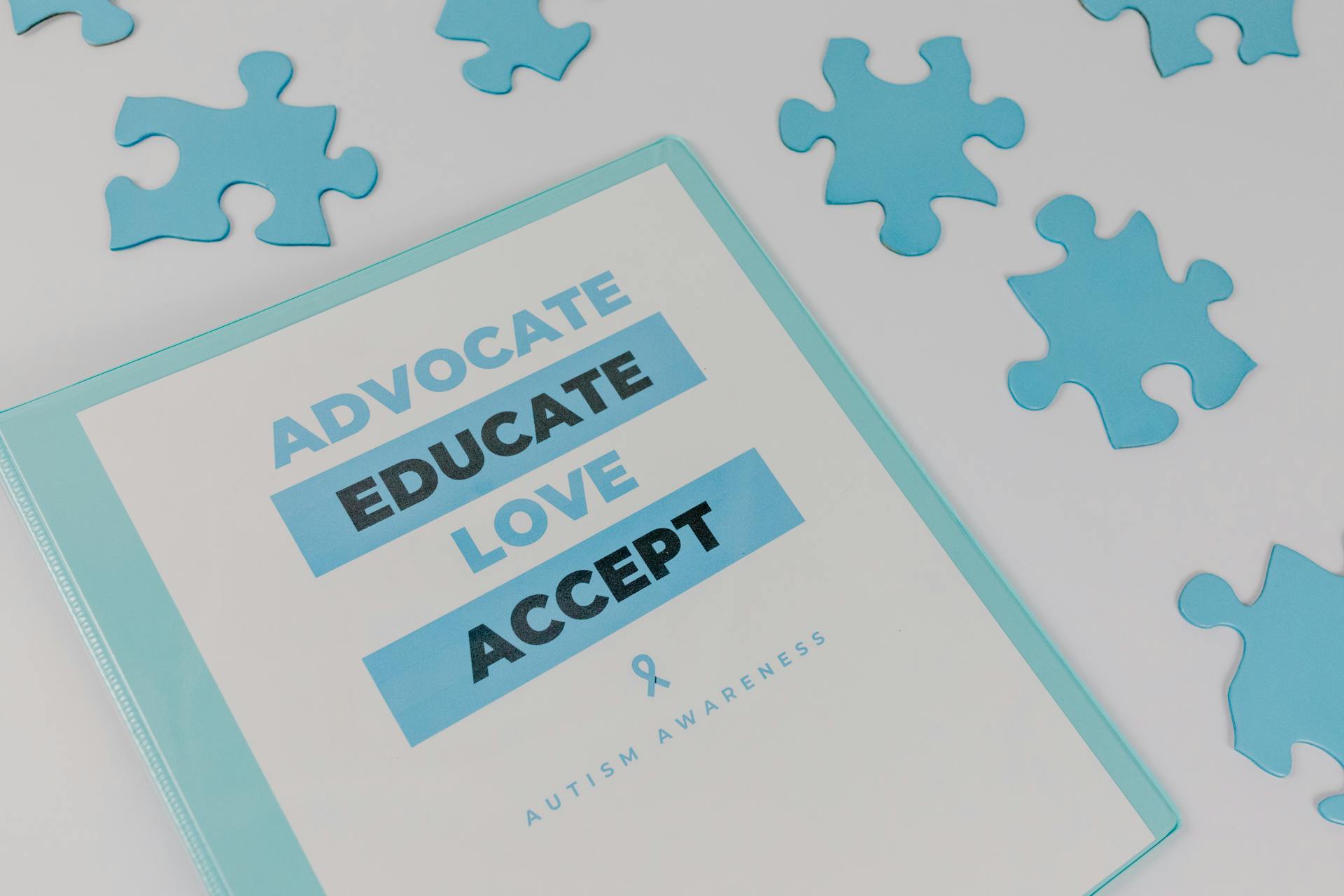
Our organization takes a thoughtful and thorough approach to matching individuals with Autism Assistance Dogs.
We start by conducting in-depth interviews to gain a better understanding of the applicant's needs and lifestyle. This interview must be attended by all members of the household.
The interview process is a crucial step in our application process, as it helps us determine the suitability of our dogs for each applicant.
After the interview, we carefully review the entire application packet to make a final decision.
The waiting period for an Autism Assistance Dog can be approximately 36 months from the time the person is accepted into our program.
Once an applicant is matched with a dog, a trainer accompanies the dog to the client's home to teach the child and family how to care for and maintain the dog's training.
Regular communication is key to the success of our program, and we require clients to report regularly on the dog's progress.
If problems arise or questions come up, our trainers are always available to offer help and answer questions.
In-home follow-up visits are also a regular part of our program to ensure the client is getting the support they need.
Program Requirements
To be eligible for an Autism Assistance Dog, you'll need to meet some specific requirements. The dog will be the only canine in your household, so if you have other pets, you'll need to rehome them.
A fenced area attached to your home is also a must. This will provide a safe space for the dog to exercise and train.
You'll need to commit to caring for the dog, which can cost upwards of $1,500 per year. This includes food, vet care, and other expenses. You'll also need to be patient and consistent in your training, rewarding the dog for good behavior.
Here are some key requirements to keep in mind:
- Fenced area attached to the home
- No other dogs in the household
- Client must be between 4-8 years old
- Minimum of one full year of training as a team
You'll also need to be willing to attend obedience training classes or hire a private trainer, as prescribed by your Dogs for Better Lives professional trainer. This will help you and your dog work together effectively.
Service Tasks and Benefits
Service tasks and benefits of autism assistance dogs include improving conversational skills, making eye contact, and teaching empathy and social cues. These skills are developed through interactions with the dog, which can facilitate conversation and help children with autism learn to read body language and facial expressions.
A service dog can also help with fine motor skills, such as taking on and off equipment and brushing the dog's fur. This can be a fun and engaging way for children to develop their dexterity and hand-eye coordination.
Daily exercising and playing games with the dog can also help with gross motor skills, such as running, throwing, and catching. These activities can be a great way for children to get exercise and have fun while developing their physical abilities.
In addition to these practical benefits, autism assistance dogs can also provide a calming effect, reduce emotional meltdowns, and provide redirection for repetitive behaviors. They can also provide companionship and a sense of security for children with autism.
Here are some of the specific tasks that autism assistance dogs can perform:
- Provides a calming effect, may increase a child’s willingness to communicate
- Provides opportunity to improve social skills
- Reduces emotional meltdowns
- Provides redirection for repetitive behaviors
- Provides companionship
By performing these tasks, autism assistance dogs can make a significant difference in the lives of children with autism, helping them to develop important skills and improve their overall quality of life.
Children's Service Program
Our Children's Service Program is designed to provide a NEADS Service Dog for children with autism or other developmental disabilities. These dogs are trained to help with a range of tasks that can address a child's socialization skills, behavioral skills, life skills, and fine and gross motor skills.
A NEADS Service Dog is carefully selected for its special chemistry with a child, taking into account the child's personality and needs. Each dog has its own unique personality, which can be matched with an appropriate child.
The matching process involves an in-person evaluation and in-take interview at the NEADS campus in Princeton, MA. If you're more than 3 hours away, a Zoom interview can be conducted first.
A Service Dog can help with conversational skills by becoming the focal point for socialization and facilitating conversation in any environment. People often ask predictable questions about the dog, which can help the child learn rote answers and connect with others.
A Service Dog can also help with eye contact by being trained to make eye contact, which can translate into the child making eye contact with people. This can be a great way to help the child build confidence and improve their social skills.
Regulating emotions is another area where a Service Dog can be helpful. Task work such as "visit" or "lap" provides a tactile way for the child to soothe themselves. This can be especially helpful during transitions, such as going from school to home.
A Service Dog can also help with transitions by serving as a focal point and providing a sense of comfort and security. For some children, exercising their dog becomes a transitional tool that allows them to more easily move to the next activity.
In some cases, a child with autism may have an increased sense of independence due to their interactions with the autism assistance dog. The dog can help the child navigate social situations and build confidence.
Autism assistance dogs are also trained to protect the safety of the children they work with, such as preventing them from leaving the house unsupervised. They can also alert parents of potential dangers and help the child navigate overwhelming situations.
Sources
Featured Images: pexels.com
